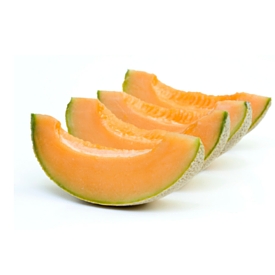Cantaloupe
 Cantaloupes, also called muskmelons, have a distinct netted or webbed rind. Dating back beyond 2400 B.C., it is likely the cantaloupe originated in Persia or possibly Afghanistan. In that time, cantaloupes were cultivated over quite a wide span – from Egypt and across to Northwest India. These sweet and juicy melons were the food of royalty for many cultures.
Cantaloupes, also called muskmelons, have a distinct netted or webbed rind. Dating back beyond 2400 B.C., it is likely the cantaloupe originated in Persia or possibly Afghanistan. In that time, cantaloupes were cultivated over quite a wide span – from Egypt and across to Northwest India. These sweet and juicy melons were the food of royalty for many cultures.
In about 1881, France was the first country to export cantaloupes to the United States. It wasn’t until 1895 that commercial production in the U.S. of the cantaloupe began, surprisingly, in the state of Colorado. Today, California is responsible for the majority of the cantaloupe crop in this country.
The cantaloupe is 95% water, and all that sweetness comes from the other 5% of the fruit. Cantaloupes are a low calorie, highly nutritious, nearly no fat treat. One-fourth of a medium sized cantaloupe provides 80% of the recommended daily allowance for both vitamins A and C. Cantaloupes also contain some iron, calcium, fiber and protein.
In earlier cultures, cantaloupes were thought to have great medicinal properties that included cleansing the body and the skin. These early herbalist were on the right track. Today we know cantaloupes may be helpful to people with heart disease because they contain an anticoagulant called adenosine. They also contain a high level of beta carotene, an antioxidant that’s associated with cancer prevention. Abundant in potassium, cantaloupes may also be beneficial to people with high blood pressure.
At the market
Press gently on the blossom end of the melon. It should be slightly soft. At room temperature, the blossom end should also have a subtle melon fragrance. It is sometimes hard to smell a melon in the store, because they are kept cool. Avoid a melon with a stem, because it was picked too early and will not be sweet.
Storage
Once picked, cantaloupes don’t get any sweeter. However, they do “ripen” or soften. For best results, “ripen” cantaloupes at a room temperature for two to four days. After this time, they can be stored in the refrigerator where they’ll keep another 10 to 14 days.
Preparation
Using a long, sharp knife, cut the cantaloupe in half. Using a spoon, scoop out the seeds and discard them. To remove the fruit from the rind, you can use a melon baller which will make little round-shaped melon pieces. Or you can make melon chunks by slicing the melon half into one-inch crescent moon shapes, then slide the knife around the rind edge to remove the rind. Cut the melon into bite-sized chunks.
Easy ideas to add cantaloupe into your meals
Add a dash of flavor: To always have cantaloupe on hand, cut a whole one into chunks, place the pieces in a covered container and keep the container in the refrigerator. Plain cantaloupe is delicious, but some people prefer to sprinkle their cantaloupe with salt and pepper, others add a dash of powdered ginger or cinnamon. Citrus lovers feel that a sprinkle of lemon or lime juice adds a flavor boost to the cantaloupe. Try them all and you decide which is best.
A tisket, a tasket, a colorful cantaloupe basket: Make a cantaloupe basket with a few cuts into the rind. First scoop out the seeds and discard them. Next, scoop out the fruit using a melon baller. To get nice round melon balls, twist the melon baller 2-3 times before removing the fruit ball. To your basket, add a mixture of the melon balls, watermelon chunks, blueberries, and kiwi slices.
Dress for success – the edible garnish: Impress your family by dressing up an everyday meal. Place a bamboo skewer of cantaloupe chunks alternated with strawberries and fresh mint leaves. Top the skewer with a lime wedge and place at the edge of the each person’s dinner plate or across the center.
Out of This Galaxy Cantaloupe
- 1 medium sized cantaloupe
- 1 2/3 cups of large curd cottage cheese
- 1 Tbsp. ground almonds, shredded coconut, or raisins (or a mixture)
- Drizzle of honey or maple syrup
Directions: Using a large, sharp knife, cut the cantaloupe crosswise into rings. Trim off the rind and scoop out the seeds. Place each ring on a plate and carefully cut the ring into bite-sized pieces while keeping the ring shape. Using an ice cream scoop, fill the center with a scoop of cottage cheese (about 1/3 cup). Sprinkle a planetary dusting of ground almonds, raisins and coconut over the cottage cheese and drizzle a solar spray of honey or maple syrup on top. Serve.
Awesome Cantaloupe Salsa
This salsa is terrific with tortilla chips, but also fabulous on cheese quesadillas or anything grilled.
- 1 cup of diced cantaloupe
- 1 cup of diced fresh tomatoes
- 2 tablespoons chopped red onion
- 1 tablespoon chopped cilantro
- 1 tablespoon lime juice
- ½ diced jalapeño pepper (ribbed and seeded), optional
- Salt and pepper, to taste
Add all ingredients to a bowl and toss gently.




